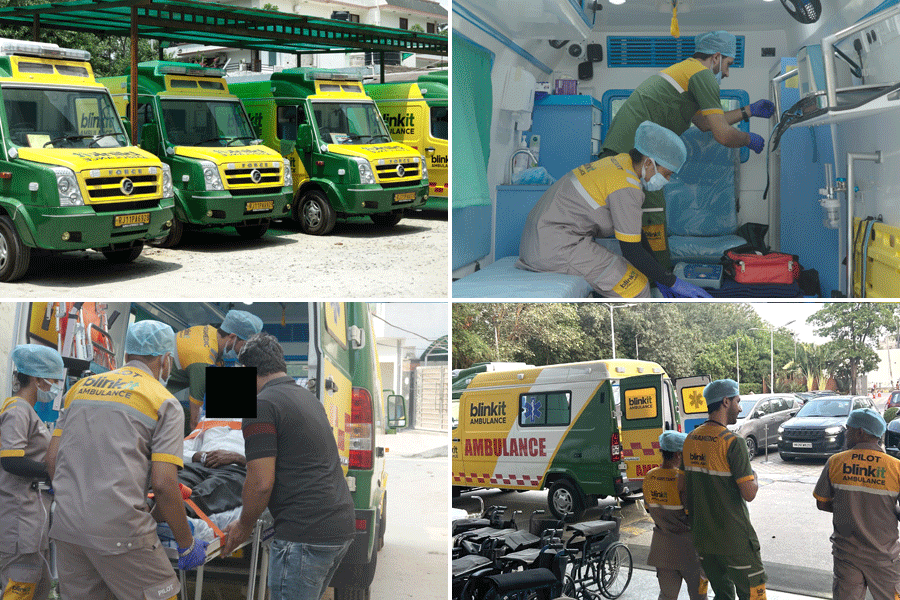 |
Neonatal jaundice affects about 60 per cent of newborn babies; the number increases to 80 per cent for pre-term infants. While deaths are rare, if left untreated neonatal jaundice may even lead to mental retardation and cerebral palsy. The only treatment is phototherapy — light in the blue spectrum can degrade the bilirubin just under the skin (which gives that yellowish tinge doctors use to diagnose jaundice) into a substance that is easily excreted in urine.
Optic fibre blankets are already being used for phototherapy of newborns with jaundice; now, scientists at the S.N. Bose National Centre for Basic Sciences in Salt Lake are working on an optic fibre sensor that will not only treat neonatal jaundice but also diagnose it.
Samir Kumar Pal and his team are trying to build a non-invasive device that will degrade bilirubin as soon as it detects high levels of it in blood.
The team of four has used a single silica fibre to make the device for the experiment. To mimic the skin in the laboratory, a 400 micron thick and five inch long cellulose paper membrane with a blood mimic consisting of haemoglobin, human serum, albumin and bilirubin has been used. Since bilirubin absorbs blue light, a blue light emitting diode (LED) was attached to the silica fibre. An optical power meter was attached to the other end of the fibre, which can continuously monitor the levels of bilirubin that gets degraded under the blue light.
While the bilirubin is degraded by blue light emission, no other key blood components reacted to it or were affected by it. “Within four hours, the level of bilirubin dropped more by than 80 per cent, which is normal. We used 100 micromolar of bilirubin which is more or less the amount present in any hyper bilirubinemia patient,” says professor Pal, who led the project.
The experiment has already been successfully conducted on 60 adult mice in a controlled manner where jaundice was created by giving each mice 100mg of paracetamol daily.
Pal and team plan to repeat the experiment on baby rats in December this year in collaboration with their counterparts in the physics department of Jadavpur University. “This would be a bit complex. We plan to create jaundice in pregnant mice in a conditioned environment with the help of a neonatal jaundice specialist and then treat the new-born baby mice by placing them all in a blanket made of woven optic fibre,” explains Nabarun Polley, a Phd student of biomedical instrumentation at S.N. Bose National Centre for Basic Sciences and a member of the research team.
Once the experiment with baby rats is successful, human trials may begin in SSKM hospital’s neonatal ward. “The outcome of the experiment on 60 mice has been very encouraging. But before we carry out the tests on baby rats, we would like to do a few more tests on adult mice. If the entire process runs successfully, it would help in treating neonatal jaundice better,” says Sukhen Das, professor of biophysics at Jadavpur University.
One of the main problems with neonatal jaundice is that it gives no time for treatment — the entire process from diagnosis to treatment should be done within two hours, because by then the chance of the bilirubin reaching the brain rises manifold. This is why theranostics is very critical. Theranostics, explains Pal, is a process by which the diagnosis and treatment of a disease take place simultaneously. “The instrument that we are planning to make will not only detect jaundice but cure it at the same time too, which will decrease the chances of infant deaths,” says Pal.
The scientist claims that theranostics is not very popular in India. Even in an advance country like the US, only a few types of cancer are being treated using the process. According to Thomson Reuters Web of Science report 2014, only 30 papers have been published worldwide in the field of non-invasive theranostics in the last 20 years. And these papers are mostly on imaging, cancer treatment and drug delivery, not on jaundice detection and therapy.
Pal and his team are planning to weave a blanket out of optic fibres with a blue LED connected to one end and a monitor to the other. The baby can be easily wrapped in the blanket and given blue ray therapy, which will not only detect jaundice but also reduce the bilirubin, bringing it back to normal. “The machine can be run both on electricity and batteries. To make it flexible and facilitate telemedicine, we are thinking of making a mobile app too, so that it can be made available on mobile phones and results obtained even while on the move,” says Pal.
“If neonatal jaundice can be detected in a non-invasive method, it will be great because it’s difficult to draw blood from infants for testing. And if simultaneous treatment can be made available in a country like ours, nothing could be better,” says Dr Sabyasachi Mukherjee, neonatalogist attached to Park Clinic, Calcutta.
The cost of the machine would be Rs 3,000 to Rs 5,000. “We are getting a lot of calls for the manufacturing rights of the machine. But we will keep the patent and only give the rights to those who keep the cost to the minimum level to make it affordable,” stresses Pal.
If Pal is successful, we’ll have some very snug babies.











